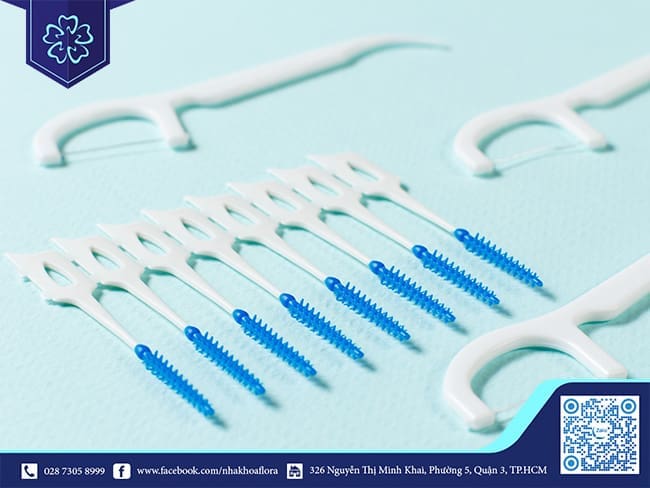Dentists often recommend flossing instead of toothpicks. So use this tool properly, let’s read the article below from Flora dentistry.
1/ Origin
Flossing was first mentioned in 1819 by American dentist Levi Spear Parmly. In 1962, the instrument was patented for the first time by Asahel M. Shurtleff, which has a form that closely resembles that of today’s only types.
Floss is a thin, soft, elastic rope, made from nylon or plastic. It is divided into two categories:
- Multifiber: made from many small piece nylon fibers, covered with wax or not, have a mild cool aroma, quite thin, good elastic, easy to rag and tear small threads when made.
- Single fiber (also known as PTFE only): made from a PTFE plastic fiber is quite thin, quite slippery, small in diameter, easy to slip through the teeth, including narrow teeth, not easy to be used.
There are currently two types of sales on the market:

- The form of curling in a small box, the user can cut out according to the length suitable for his teeth and mouth.

- Toothpicks with short threads are fixed on a small C-shaped bow.
Depending on habits and preferences, each person can choose the only one that does not damage the gums during use.
Everyone should use flossing, including children, to remove leftover food plaque between the teeth that toothbrushes can’t clean. Thereby preventing the growth of bacteria and the accumulation of plaque on the teeth. Flossing, we can control and clean each tooth one by one, effectively preventing gum diseases.
2/ How to floss properly
Cut a segment only about 30-45 cm long to comfortably move between the tooth slits.
How to control only:
Wrap the thread tightly in the middle of your hands and hold back with your thumb. It is recommended to use the thumb for the upper teeth, the middle finger for the lower teeth.
Upper function: Place 2-5 cm apart, put flossing in the interture, one thumb stands still and the other makes up and down movements along the teeth, forming a gentle movement that removes bacteria from the interstitial teeth.
Lower function: One middle finger remains stationary, the other middle finger moves up and down between the teeth, similar to the upper jaw.
Depending on the amount of plaque on the teeth more or less, the duration to clean the process with flossing takes 1 minute.
You should floss after brushing your teeth and rinse your mouth with a mouthwash after you’ve done it.
If you find it too difficult to floss, you can use toothpicks more easily.

3) Consequences if used incorrectly
Use too much force to clean teeth: Many people are not used to using too strong force, the dental thread rubbed against the gums is a tear of the gums causing damage to soft tissue, leading to bleeding or separation of the legs clinging to the gums with teeth.
Excessive savings: A short section should be used to clean each tooth. Some people are too frugal to share a paragraph just for all the teeth. Since then, the bacteria spread to a large area, easily causing bad breath. Dentists recommend using a length of over 30 cm for easy control.
Use large threads and scleroderma: Large threads, scleroderma is no different from toothpicks, if you use it for a long time the teeth may be thinning. You should choose thin, small, soft threads to avoid damage to tooth enamel and teeth will not be thinned.
Flora Dentistryhopes that the above information will help you use proper flossing and oral hygiene in the most effective way so that your teeth are always healthy, beautiful white, confident.
